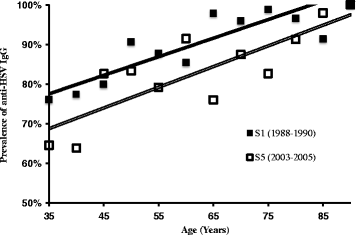Herpes virus seroepidemiology in the adult Swedish population
- PMID: 28491117
- PMCID: PMC5424393
- DOI: 10.1186/s12979-017-0093-4
Herpes virus seroepidemiology in the adult Swedish population
Abstract
Background: Herpes viruses establish a life-long latency and can cause symptoms during both first-time infection and later reactivation. The aim of the present study was to describe the seroepidemiology of Herpes simplex type 1 (HSV1), Herpes simplex type 2 (HSV2), Cytomegalovirus (CMV), Varicella Zoster virus (VZV) and Human herpes virus type 6 (HHV6) in an adult Swedish population (35-95 years of age).
Methods: Presence of antibodies against the respective viruses in serum from individuals in the Betula study was determined with an enzyme-linked immunosorbent assay (ELISA). Singular samples from 535 persons (53.9% women, mean age at inclusion 62.7 ± 14.4 years) collected 2003-2005 were analyzed for the five HHVs mentioned above. In addition, samples including follow-up samples collected 1988-2010 from 3,444 persons were analyzed for HSV.
Results: Prevalence of HSV1 was 79.4%, HSV2 12.9%, CMV 83.2%, VZV 97.9%, and HHV6 97.5%. Herpes virus infections were more common among women (p = 0.010) and a lower age-adjusted HSV seroprevalence was found in later birth cohorts (p < 0.001). The yearly incidence of HSV infection was estimated at 14.0/1000.
Conclusion: Women are more often seropositive for HHV, especially HSV2. Age-adjusted seroprevalence for HSV was lower in later birth cohorts indicating a decreasing childhood and adolescent risk of infection.
Keywords: Cytomegalovirus; Epidemiology; Herpes; Herpes simplex; Seroprevalence; Varicella zoster virus.
Figures
Similar articles
-
Seroprevalences of varicella-zoster virus, herpes simplex virus and cytomegalovirus in a cross-sectional study in Mexico.Vaccine. 2013 Oct 17;31(44):5067-74. doi: 10.1016/j.vaccine.2013.08.077. Epub 2013 Sep 7. Vaccine. 2013. PMID: 24021305
-
Seroprevalence, incidence of prenatal infections and reliability of maternal history of varicella zoster virus, cytomegalovirus, herpes simplex virus and parvovirus B19 infection in South-Western Finland.BJOG. 2005 Jan;112(1):50-6. doi: 10.1111/j.1471-0528.2004.00320.x. BJOG. 2005. PMID: 15663397
-
The diagnostic significance of enzyme linked immuno-sorbent assay for herpes simplex, varicella zoster and cytomegalovirus retinitis.Indian J Ophthalmol. 2003 Mar;51(1):71-5. Indian J Ophthalmol. 2003. PMID: 12701866
-
Herpesviruses and the microbiome.J Allergy Clin Immunol. 2013 Dec;132(6):1278-86. doi: 10.1016/j.jaci.2013.02.039. Epub 2013 Apr 20. J Allergy Clin Immunol. 2013. PMID: 23611298 Review.
-
A comparison of herpes simplex virus type 1 and varicella-zoster virus latency and reactivation.J Gen Virol. 2015 Jul;96(Pt 7):1581-602. doi: 10.1099/vir.0.000128. Epub 2015 Mar 20. J Gen Virol. 2015. PMID: 25794504 Free PMC article. Review.
Cited by
-
A genetic signature including apolipoprotein Eε4 potentiates the risk of herpes simplex-associated Alzheimer's disease.Alzheimers Dement (N Y). 2019 Nov 4;5:697-704. doi: 10.1016/j.trci.2019.09.014. eCollection 2019. Alzheimers Dement (N Y). 2019. PMID: 31921962 Free PMC article.
-
Presence of the Human Cytomegalovirus in Glioblastomas-A Systematic Review.Cancers (Basel). 2021 Oct 9;13(20):5051. doi: 10.3390/cancers13205051. Cancers (Basel). 2021. PMID: 34680198 Free PMC article. Review.
-
Long-term time trends in reactivated herpes simplex infections and treatment in Sweden.BMC Infect Dis. 2022 Jun 15;22(1):547. doi: 10.1186/s12879-022-07525-w. BMC Infect Dis. 2022. PMID: 35705911 Free PMC article.
-
Oncolytic α-herpesvirus and myeloid-tropic cytomegalovirus cooperatively enhance systemic antitumor responses.Mol Ther. 2024 Jan 3;32(1):241-256. doi: 10.1016/j.ymthe.2023.11.003. Epub 2023 Nov 4. Mol Ther. 2024. PMID: 37927036 Free PMC article.
-
An Ig γ Marker Genotype Is a Strong Risk Factor for Alzheimer Disease, Independent of Apolipoprotein E ε4 Genotype.J Immunol. 2020 Sep 1;205(5):1318-1322. doi: 10.4049/jimmunol.2000351. Epub 2020 Jul 24. J Immunol. 2020. PMID: 32709662 Free PMC article.
References
-
- Arvin A, et al. Human Herpesviruses Biology, Therapy, and Immunoprophylaxis. Cambridge: Cambridge University Press; 2007. p. 1. - PubMed
LinkOut - more resources
Full Text Sources
Other Literature Sources


